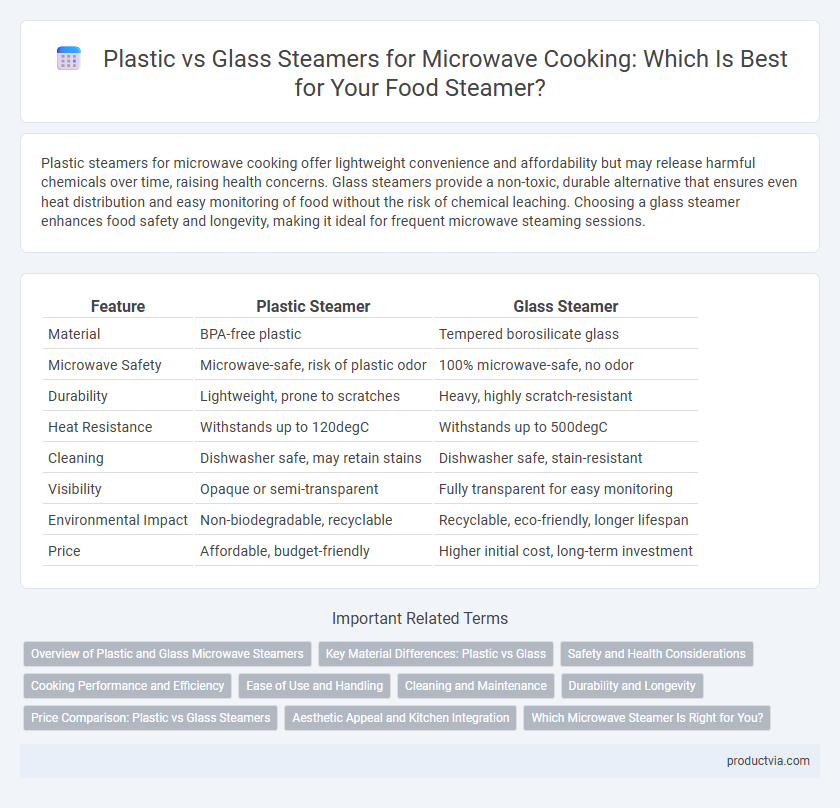Plastic steamers for microwave cooking offer lightweight convenience and affordability but may release harmful chemicals over time, raising health concerns. Glass steamers provide a non-toxic, durable alternative that ensures even heat distribution and easy monitoring of food without the risk of chemical leaching. Choosing a glass steamer enhances food safety and longevity, making it ideal for frequent microwave steaming sessions.
Table of Comparison
| Feature | Plastic Steamer | Glass Steamer |
|---|---|---|
| Material | BPA-free plastic | Tempered borosilicate glass |
| Microwave Safety | Microwave-safe, risk of plastic odor | 100% microwave-safe, no odor |
| Durability | Lightweight, prone to scratches | Heavy, highly scratch-resistant |
| Heat Resistance | Withstands up to 120degC | Withstands up to 500degC |
| Cleaning | Dishwasher safe, may retain stains | Dishwasher safe, stain-resistant |
| Visibility | Opaque or semi-transparent | Fully transparent for easy monitoring |
| Environmental Impact | Non-biodegradable, recyclable | Recyclable, eco-friendly, longer lifespan |
| Price | Affordable, budget-friendly | Higher initial cost, long-term investment |
Overview of Plastic and Glass Microwave Steamers
Plastic microwave steamers offer lightweight, affordable, and heat-resistant options designed to withstand typical microwave temperatures, often featuring BPA-free materials to ensure food safety. Glass microwave steamers provide superior durability, non-reactive surfaces, and even heat distribution without the risk of chemical leaching, making them ideal for health-conscious users. Both types typically include vented lids for steam release and come in various sizes to accommodate different cooking needs, but glass steamers require more careful handling due to their weight and fragility.
Key Material Differences: Plastic vs Glass
Plastic steamers are lightweight, durable, and typically BPA-free, making them safe for microwave cooking, while offering excellent heat resistance and easy handling. Glass steamers provide superior heat retention, are non-porous, and do not absorb odors or stains, ensuring food purity and a more even cooking process. The key material differences highlight plastic's flexibility and shatter resistance versus glass's chemical inertness and visual clarity during steaming.
Safety and Health Considerations
Plastic steamers often contain BPA or other harmful chemicals that may leach into food during microwave cooking, raising health concerns. Glass steamers are non-porous, free from toxins, and resist staining or odor absorption, making them a safer choice for repeated microwave use. Opting for BPA-free plastic or borosilicate glass steamers ensures enhanced safety and better preservation of food quality during steaming.
Cooking Performance and Efficiency
Plastic steamers for microwave cooking offer lightweight convenience and rapid heat conduction, but may absorb odors and discolor over time, potentially affecting cooking performance. Glass steamers provide superior heat retention and even steam distribution, enhancing cooking efficiency and preserving food texture without chemical leaching. Choosing between plastic and glass steamers depends on balancing durability, heat performance, and food safety considerations for optimal microwave steaming results.
Ease of Use and Handling
Plastic steamers for microwave cooking are lightweight and typically feature flexible lids and ergonomic handles, making them easy to handle and store. Glass steamers offer the advantage of visibility, allowing users to monitor the cooking process, but are heavier and more fragile, requiring careful handling. Both materials are microwave-safe, but plastic steamers often provide greater convenience in terms of ease of use and portability.
Cleaning and Maintenance
Plastic steamers for microwave cooking are lightweight and often dishwasher-safe, but they may retain odors and discolor over time, requiring more frequent deep cleaning. Glass steamers resist staining and do not absorb odors, making them easier to clean and maintain with minimal effort, though they are heavier and more fragile. Regular use of non-abrasive cleaning agents preserves the quality and lifespan of both types, but glass steamers generally offer superior hygiene and durability in maintenance.
Durability and Longevity
Glass steamers for microwave cooking offer superior durability and longevity compared to plastic steamers, as they resist staining, warping, and retaining odors over time. High-quality borosilicate glass steamers withstand repeated temperature changes without cracking, ensuring consistent performance for years. Plastic steamers may degrade faster under microwave heat, leading to potential material breakdown and reduced lifespan.
Price Comparison: Plastic vs Glass Steamers
Plastic steamers typically offer a more budget-friendly option for microwave cooking, with prices often ranging from $10 to $20, making them accessible for everyday use. Glass steamers, while generally more expensive, priced between $25 and $50, provide durability and better heat resistance for long-term cooking needs. The choice between plastic and glass steamers often balances upfront cost savings with the benefits of material longevity and safety in microwave environments.
Aesthetic Appeal and Kitchen Integration
Glass steamers offer a sleek, modern aesthetic that seamlessly integrates with contemporary kitchen designs, showcasing food clearly while enhancing countertop elegance. Plastic steamers provide lightweight convenience but often lack the refined appearance and durability of glass, making them less visually appealing in open kitchen settings. Opting for glass steamers can elevate kitchen ambiance and complement stylish cookware collections for a cohesive cooking environment.
Which Microwave Steamer Is Right for You?
Plastic steamers for microwave cooking are lightweight, affordable, and often come with vented lids to release steam safely, but they may retain odors or discolor over time. Glass steamers are microwave-safe, durable, and non-porous, ensuring no odor absorption or chemical leaching, making them ideal for those seeking a healthier cooking option. Choosing between plastic and glass steamers depends on your priorities: budget-friendly convenience versus long-term durability and food safety.
Plastic steamer vs Glass steamer for microwave cooking Infographic

 productvia.com
productvia.com